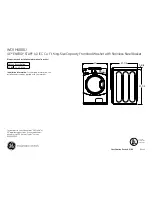
EN
10
Wash cycles
The number and type of wash cycles and options may vary depending on the dishwasher model.
Wash-cycle data is measured under laboratory conditions according to European Standard EN 50242.
Based on the different conditions of use, the wash-cycle duration and data can change.
Wash Cycle
Drying
Options
Wash Cycle
Duration
Water
Consumption (l/
cycle)
Energy
Consumption
(kWh/cycle)
1.
Eco
Yes
Half Load - Delayed Start
03:10’
11,0
1,04
2. Intensive
Yes
Half Load - Delayed Start
02:30’
16,5
1,70
3. Normal
Yes
Half Load - Delayed Start
02:00’
16,0
1,35
4. Delicates
Yes
Half Load - Delayed Start
01:30’
12,0
1,10
5. Rapid 40’
No
Delayed Start
00:40’
9,0
0,95
6. Prewash
No
Half Load - Delayed Start
00:10’
4,0
0,01
Instructions on wash-cycle selection and detergent dosage
1.
The ECO wash cycle is the standard cycle to which the energy label data refers. It can be used to wash crockery with a normal
soil level and is the most efficient cycle in terms of energy and water consumption for this type of crockery.
27 gr/ml + 6 gr/ml** – 1 Tab
(**Quantity of pre-washing detergent)
2.
Heavily soiled dishes and pans (not to be used for delicate items). 30 gr/ml – 1 Tab
3.
Normally soiled pans and dishes. 27 gr/ml + 6 gr/ml** – 1 Tab
4.
Economic and fast wash for delicate items which are sensitive to high temperatures. 30 gr/ml – 1 Tab
5.
Fast cycle to be used for slightly dirty dishes (ideal for 2 place settings) 25 gr/ml – 1 Tab
6.
Pre-wash while awaiting completion of the load with the dishes from the next meal. No detergent.
Standby consumption: Left-on mode consumption: 5,0 W - Off mode consumption: 0.5 W
Summary of Contents for DFG 26B10
Page 58: ...RU 58 ...











































